
Article contents

The current average pension pot at 30 is £9,300 (in the UK), but even if you have nothing in your pension, you can still build a very comfortable retirement – don't worry, you're still young(ish)! Whether you have retirement savings or not yet, the important thing is to start saving regularly now – we’ll show you how much below.
Good question! And a very important one. Let’s run through it – you might find it’s more than you were expecting, but don’t worry, we’ll also run through how to boost your pension pot (pension account) to provide you with the comfortable retirement you deserve (it’s easier than you think if you start now).
If you’re just here for the quick answer, here’s what the average pension pots are by age in the UK… (age 30 is £9,300).
PensionBee is our top rated provider, it’s easy to use and low cost – plus you’ll get £50 added to your pension when you open an account.
HOWEVER! That’s not the recommended pension pot size, it's just what people currently have! And it’s far smaller than what you need to have a comfortable retirement. Huh?!
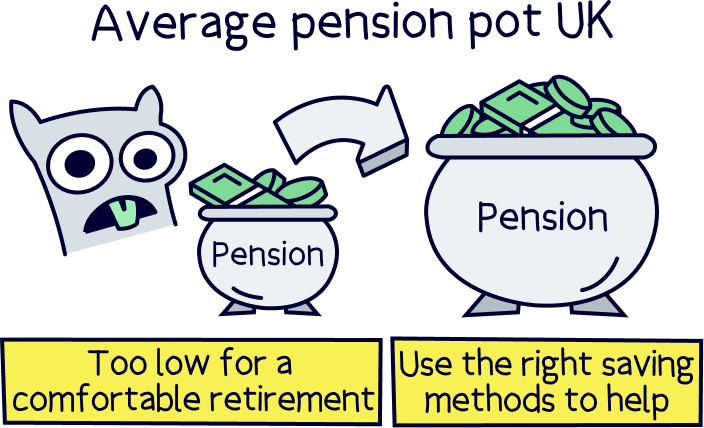
Almost everybody is saving too little into their pension – that’s because the pension pot you need for a comfortable retirement these days is pretty high.
There is some good news, if you have a job and pay National Insurance, you may get the State Pension (the government pension) when you retire (at 66). However, you’ll likely struggle to live off just this – it’s currently £11,500 per year (£221.20 per week), and you’ll get this if you pay 35 years National Insurance contributions (minimum of 10 years to get any money).
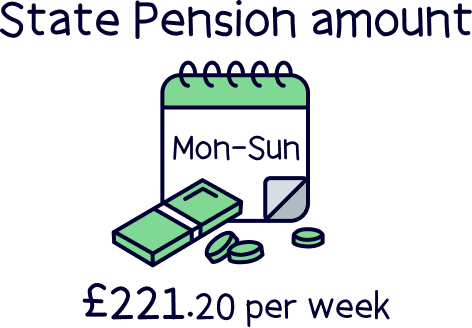
So, you’ll likely need your own pension pot alongside the State Pension in order to boost your retirement income to a liveable standard.
In fact, here’s how much you’ll need in your pension pot for the 3 key retirement income categories (we’ll explain these just after).
If you think you’ll get the State Pension, you’ll need to save a pension pot (in addition to the State Pension) of…
If you don’t think you’ll get the State Pension, unfortunately, you’ll need to save even more…
Pretty big numbers aren’t they? But don’t worry, you don’t need a massive pension pot right now (at 30) in order to achieve it. If you haven’t saved anything into a pension yet, it’s not a massive problem either.
Building up a pension pot is really quite simple (on paper), and it's all down to saving regularly, and starting right now! We’ll cover how your money can grow over time, just below.
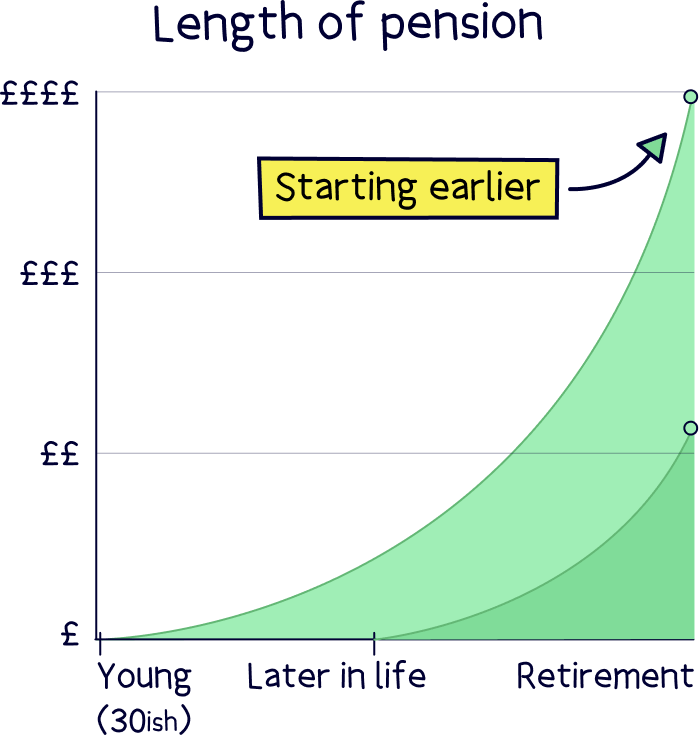
Before that, let’s quickly run through the 3 income levels we’ve mentioned above. They’re part of Retirement Living Standards, created by the Pensions and Lifetime Savings Association. They’ve worked out how much you’ll need as an income in retirement (usually a pension), broken down into 3 categories, minimum, moderate and comfortable…
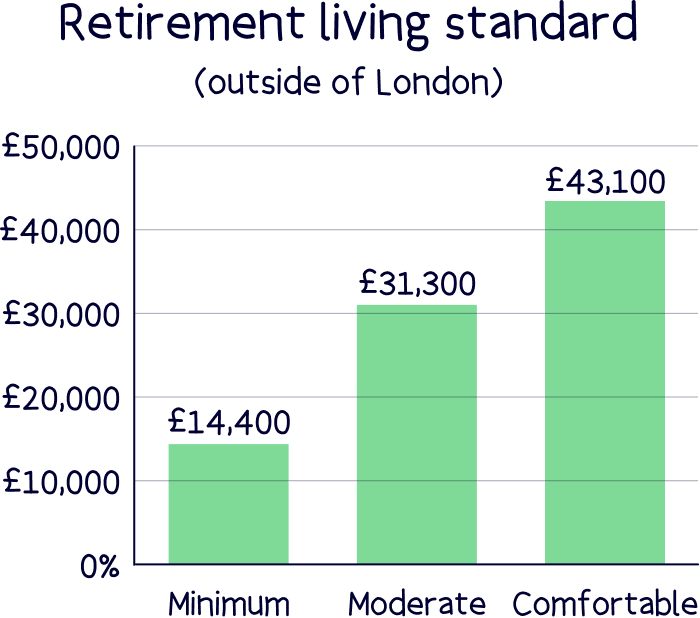
This is £14,400 per year for one person, or £22,400 for a couple. It’s the minimum you’ll need to live, and covers all your basic needs. There’s £50 per week for food, and £630 for clothing per year. You won’t be able to afford a car, but there is a little bit left over each year for fun, such as a week's holiday.
In London, this rises to £15,700 for one person, and £24,500 for a couple.
This is £31,300 per year for one person, or £43,100 for a couple. There’s more flexibility and financial security, but you’ll likely still struggle. You’ll have £55 per week for food, be able to have a small old car, and enough for a 2 week holiday abroad each year.
In London, this rises to £32,800 for one person, and £44,900 for a couple.
This is £43,100 per year for one person, and £59,000 for a couple. There’s freedom to do lots more things, but you might still need to budget. There’s £70 per week on food, a 2 year old car, and a 3 week holiday abroad to Europe each year.
In London, this rises to £45,000 for one person, and £61,200 for a couple.
The average retirement income right now (in the UK) is £361 per week, which works out at £18,772 per year, or £1,564 per month (GOV.UK). That’s above the minimum, but lower than a moderate retirement.
Now let’s take a look at how much you’ll need to save each month, whether you’ve got the average pension pot at 30 (£9,300), or you haven’t got a pension yet (don’t panic!).
For the calculations, we’ve used a retirement age of 68, which is likely what the State Pension retirement age could be in future. Although you can of course, decide to retire earlier, or later, depending on your circumstances.
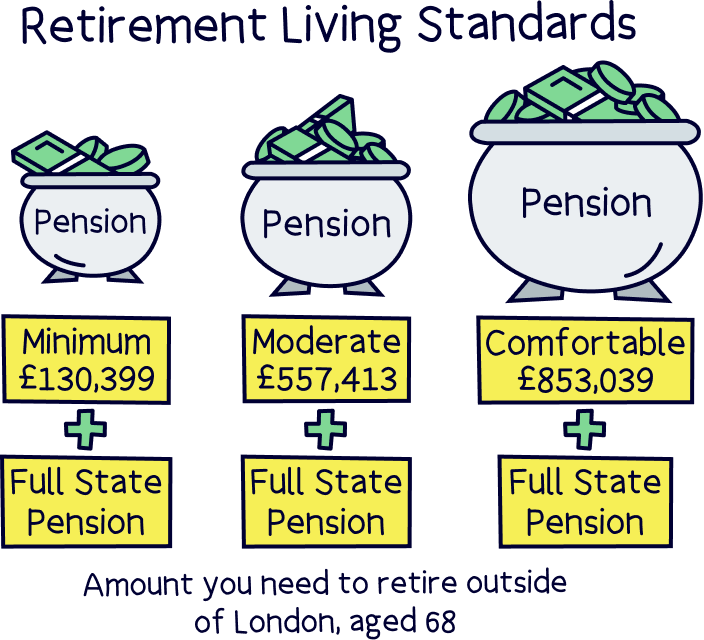
Don’t panic just yet. This shows how much you need to contribute to your pension in total every month (in order to build a pension pot big enough for your desired retirement income). The great thing about pensions is there’s lots of free cash that gets added to your pension pot too…
If you have a pension through work, set up by your employer (called a workplace pension), when you add 5%, they’ll also have to add 3% themselves (by law, called employer contributions). It’s like a free pay rise!
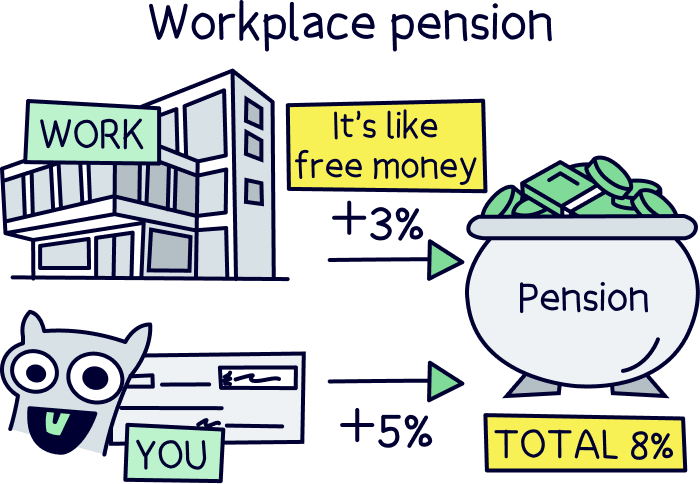
If you're saving into a pension you set up yourself, called a personal pension (and highly recommended in addition to a workplace pension), you’ll get a massive 25% bonus from the Government added automatically, on everything you add (we’re not joking!).
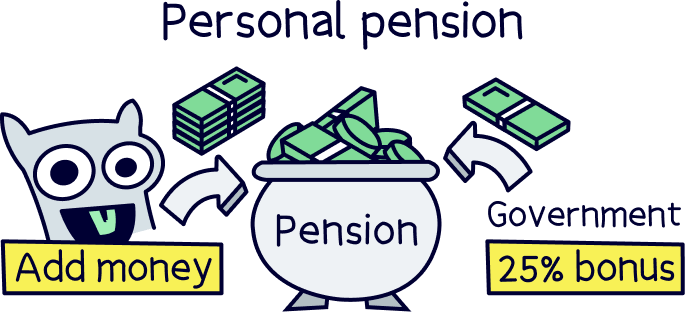
This is because saving into your pension is intended to be tax-free, but you'll already have paid tax on your income (e.g. your salary) before you pay into your pension, so it’s the tax you’ve paid being refunded back into your pension.
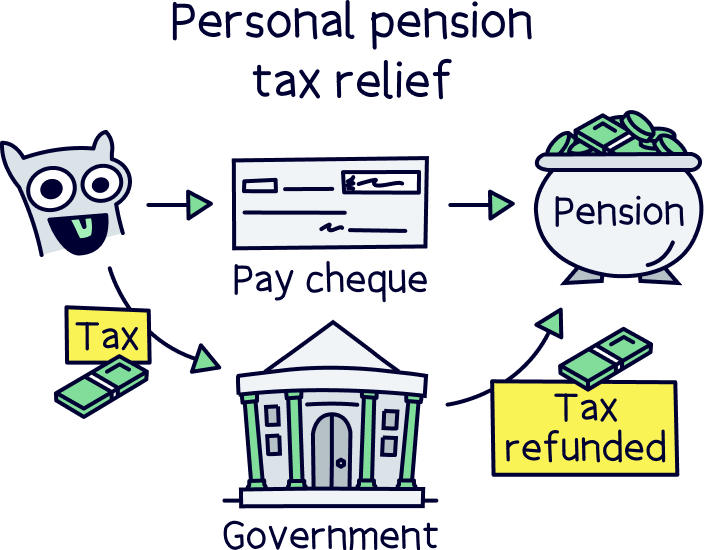
If you earn over £50,270 per year, and pay higher rate tax (40%), or additional rate tax (45%), you’ll also be able to claim some of this tax back too (on a Self Assessment tax return).
We’ll cover personal pensions in more detail below – but they’re a great way to boost your pension pot. If you're already sold, check out PensionBee¹ – they’re 5* rated, easy to use and have low fees (plus you’ll get £50 added to your pension for free too). Or, check out the top pension providers.
With all that free cash, those pension pots are a bit more achievable. Let’s run through a quick example…
Imagine you earned £2,000 per month from your job. If you were saving 5% of your annual salary per month, so £100 per month, your employer would have to add 3%, which is £60 – all for free.
So, your total contributions would be £160 per month. That’s over 50% of your contributions completely free. That’s the minimum pension income sorted (if you’re 30 years old).
If you decide you wanted to save more into your pension, aiming for a moderate-to-comfortable retirement (highly recommended), and were to pay an extra £100 into a personal pension alongside your workplace pension, you’d get a massive £25 added to your pension (from the Government), every time you saved. Pretty great right?
This means by paying £200 per month into your pension pots, you’ll get £95 added into your pension too, completely free – boosting your pension pot massively over time.
Of course, if you’re able to save even more, you’ll get even more free money! So you can see how those big monthly numbers aren't actually as big as they seem.
Nuts About Money tip: check out PensionBee’s pension calculator to work out how much you might want to save based on your own personal circumstances.
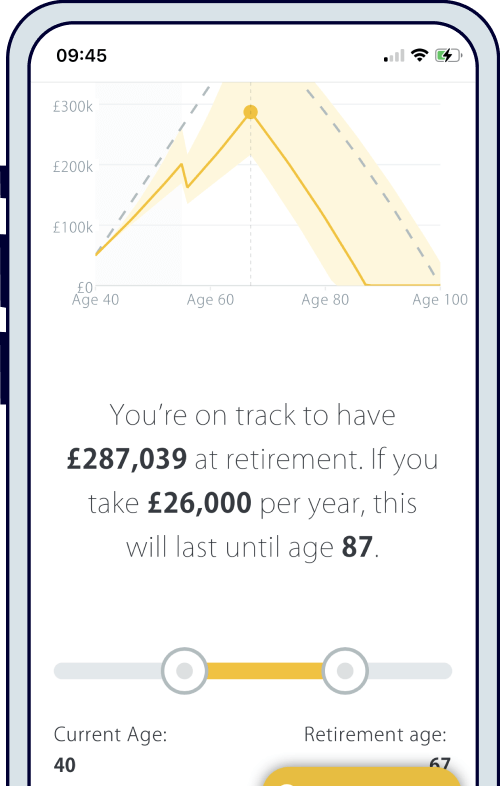
It’s a bit old fashioned now, but the old rule of thumb is that you should have a pension pot that’s equal to your current annual salary at 30 (called the 'age rule').
So, if you’re earning £25,000, your pension pot should also be £25,000 at 30.
However, we say it’s old news now, as everyone is unique, and life and jobs change much quicker these days – our annual salary can chop and change over time – both up and down.
Meaning, we don’t necessarily want to keep the same standard of living we have now at 30, into retirement, we might be expecting to earn considerably more, and want a much better quality of life.
It’s a better idea to determine what sort of retirement income you’d be happy with, and then aim to build your retirement savings to provide that income, rather than worrying about how much you should have in your pension pot right now at your current age.
30 is still very young when it comes to pensions (and your working career) – there’s lots of time to build a big pot if you start today.
Nuts About Money tip: financial advisors can be a great idea to help with retirement planning and retirement goals, if you think you might like a bit more help here’s our guide to financial advisors.
There’s a few great ways to boost your pension pot…
First, if you’ve got a very nice employer, they might add even more than the minimum 3%, providing you add more too. This is even more free cash, so snap it out of their hands if you can!
If they don’t, and you want to save more than 5% into your pension (recommended), it’s a good idea to save into a personal pension instead.
This is because with a personal pension, you get to decide which pension provider (pension company) you want to use, instead of your employer picking one (and they don’t always pick great ones).
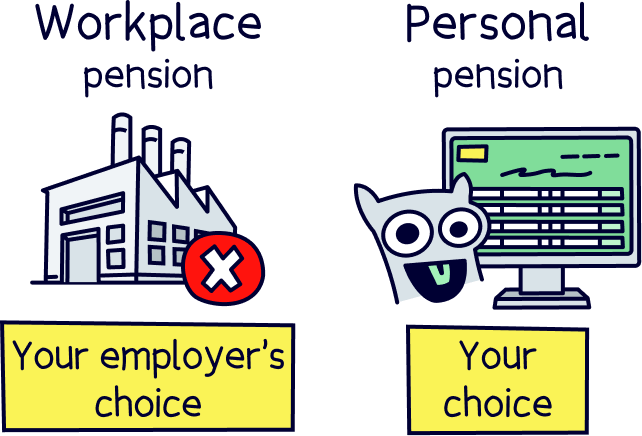
Imagine being stuck on a bad mobile phone contract, paying too much for not enough minutes and data, and never being able to switch until you move jobs – that can be some workplace pensions.
With a personal pension, you can pick one that’s easy to use, has low fees and a great track record of growing pensions over time. Our top pick for this is PensionBee¹, for all of those reasons – but here’s all the best personal pensions for you to compare.
You can also move your personal pension to another provider in future (which you can’t do with your current workplace pension), and you can even transfer any old pensions over too (called consolidating your pension)...
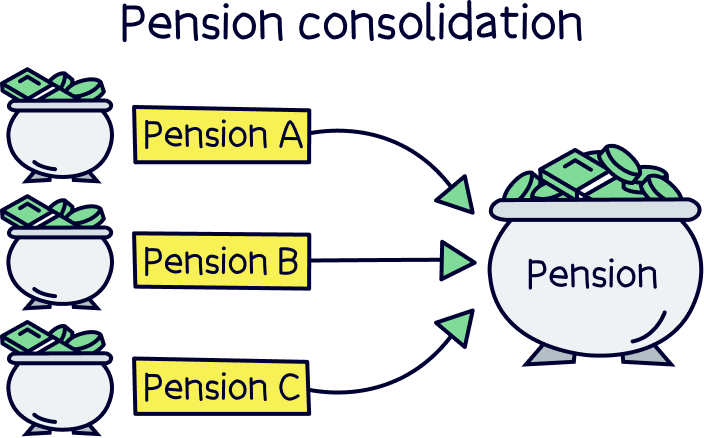
Consolidating your pension could mean less fees overall, as firstly, the fees might be lower anyway, but also some providers charge less fees the more money you have in them. This would allow your pension to grow even more over time.
Plus, you won’t forget about where all your old pensions are – potentially missing out when it comes to retire later down the line.
Once you’re set up, simply start saving (monthly if you can), and as much as you can reasonably afford (without overstretching yourself). Your pension pot will soon add up, and you’ll begin to benefit from compound interest…
Compound interest is where the money you make (your retirement savings growing), begin to make money too – and this snowballs over and over, turning small sums into very large sums over time. You really will be surprised by how big your pension pot could grow!
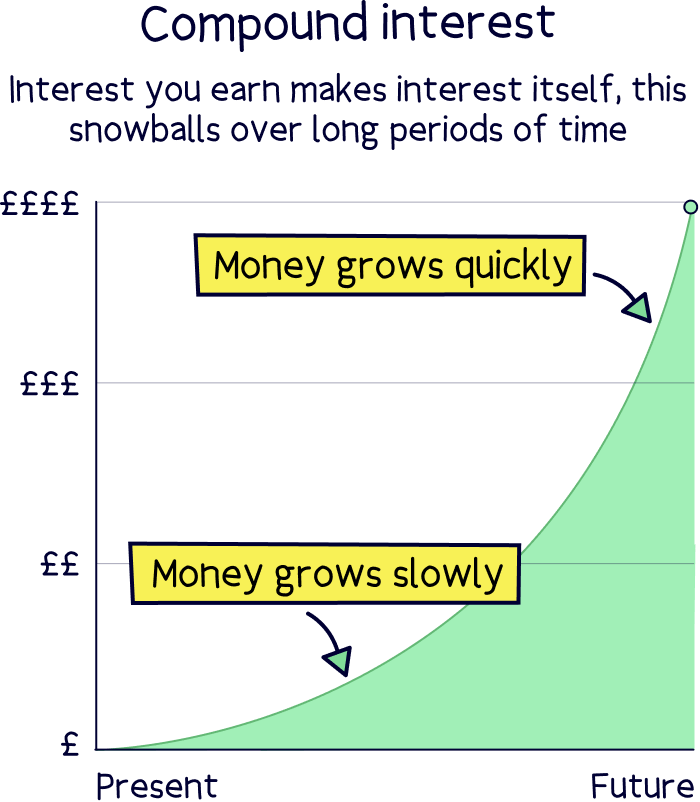
If you are looking to save more into a personal pension, here’s our top recommendations:
Get £50 added to your pension



PensionBee is our recommended provider – they’ve thought of everything.
Their 5 star rated app (and website) makes it easy to set up and use. You can open a brand new pension, or transfer your existing pensions across (they’ll handle all the paperwork).
Simply pick from an easy to understand range of pension plans, and that’s it, the experts manage everything from there.
It’s low cost, with one simple annual fee. The customer service is excellent, and you’ll get a dedicated account manager for any questions you might have.

And, when the time comes to retire, withdrawing from your pension is easy too.
You can also use them if you're self-employed or a company director.
Welcome bonus of £20-£100 + further bonus available



InvestEngine is a super low cost investment platform allowing you to save and invest within a pension and an ISA, and with a great range of investment options.
There's no fees for an account, and no commission to buy and sell investments. And there’s a wide range of investment options, with over 700 investment fund options (ETFs only).
It's more than just low cost though, it’s pretty easy to use, there’s some great features to help you invest, and the customer service is excellent.
Minimum deposit: £100
Best for: those looking for a low cost platform with a range of fund options

• Easy to use
• Very low cost
• Commission-free
• Great range of ETFs
• Great customer support
• Only ETFs (but a wide range)
• No financial advice
PensionBee is our top rated provider, it’s easy to use and low cost – plus you’ll get £50 added to your pension when you open an account.
Private pensions are pensions that aren’t the government pension (the State Pension). So, a workplace pension (a pension set up by your employer), and a personal pension (a pension you set up yourself), are both types of private pensions.
A personal pension is one you set up yourself, and if you hadn’t noticed yet, we think they’re pretty great.
When you save into one, you’ll get a big 25% bonus from the Government, added automatically. And, your money grows tax-free – so it can potentially grow far bigger over time.
You can save as much as your total income (e.g. your salary), or £60,000, whichever is lower, each tax year (which runs from April 6th to April 5th the following year).
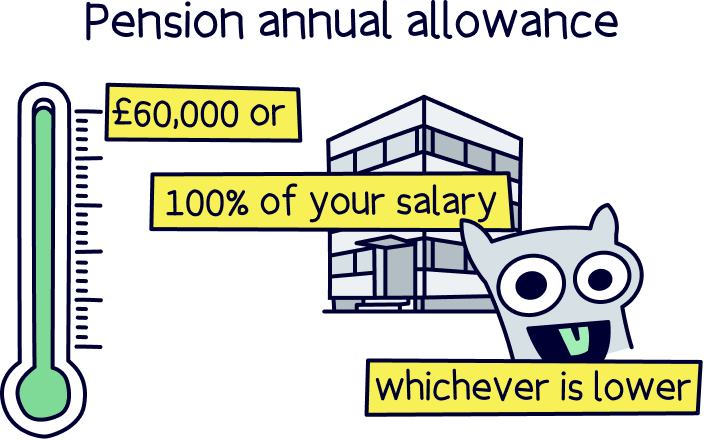
You can’t withdraw your money until you’re at least 55 years old (57 from 2028) – it’s intended for retirement after all.
And when you do come to withdraw it, 25% will be completely tax-free. You might pay tax on the remaining 75%, it all depends on your income at the time, and the tax you’ll pay is the same as your income now (Income Tax).
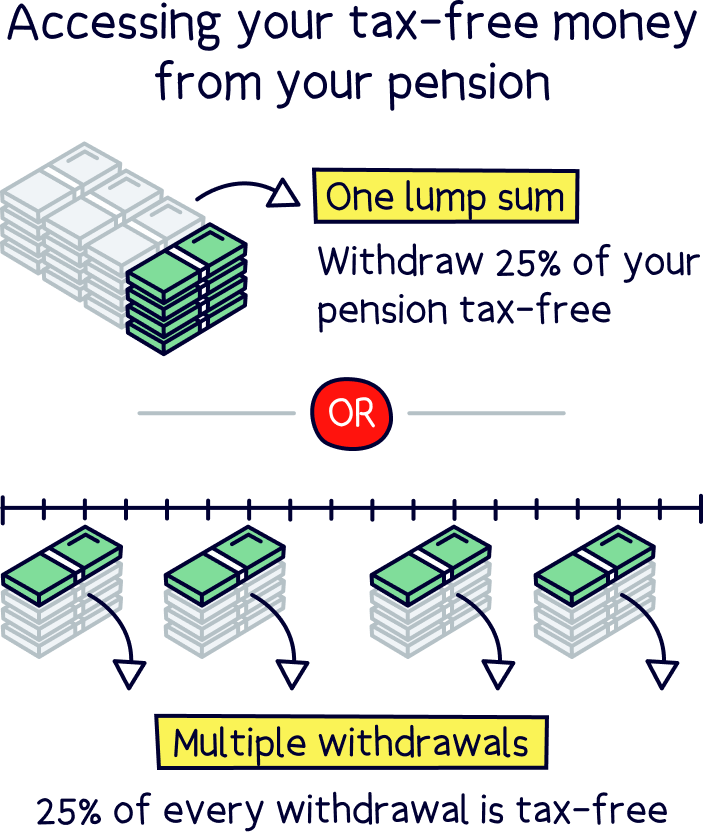
There’s two main types of personal pensions, an expert-managed personal pension, and a self-invested personal pension (SIPP).
Nuts About Money tip: we’ve got a guide to starting a pension if you’d like to learn even more.
An expert-managed personal pension is where, you guessed it, experts handle the investments, with a strategy to grow your pension sensibly over time. All you need to do is pick from simple, easy to understand pension plan options, and add money. There are experts on hand to help too.
We highly recommend this option for most people, and PensionBee¹ is a great option here.
A type of personal pension is a self-invested personal pension (SIPP). These are where you make your own investment decisions with your money in your pension…
You can pick from a huge range of investments such as stocks and shares (where you own part of the company, a share of a company), and investment funds (groups of investments pooled together into a single investment) – and there’s specific investment funds for pensions, called pension funds.
You’ll still get the great pension tax relief too (the 25% bonus, and be able to claim back more tax if you pay it too (the 40% or 45% if you’ve paid it on your annual income)).
These are only recommended for experienced investors – it’s often better to simply let the experts handle things when it comes to your pension (and most investing).
However, if these sound interesting, here’s our guide to the best SIPP providers.
Note: modern personal pensions can also be called SIPPs – but they simply offer a very limited range of pension plans (pension investments) where the experts handle things, such as PensionBee¹ and Moneyfarm¹ (both great options).
Yep. It’s perfectly safe to use a personal pension provider. Pension providers need to be authorised by the Financial Conduct Authority (FCA), they’re the people who make sure financial services companies are looking after you and your money.
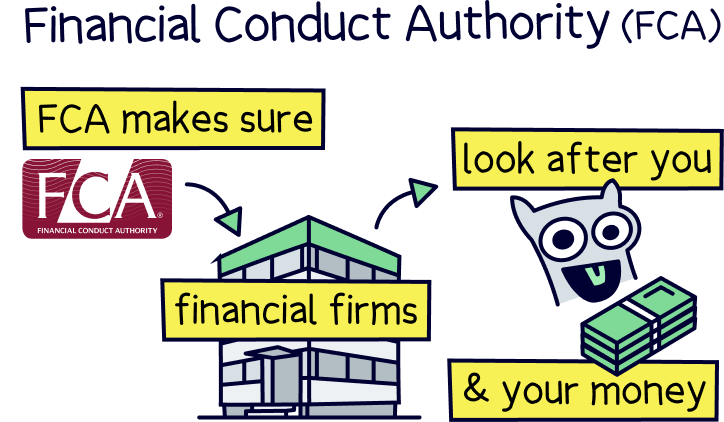
You can check if a company is authorised by the FCA on the FCA register.
That also means your money is protected by the Financial Services Compensation Scheme (FSCS). That’s where you’ll be compensated by up to £85,000 (and sometimes 100%), if your pension provider were to go out of business.
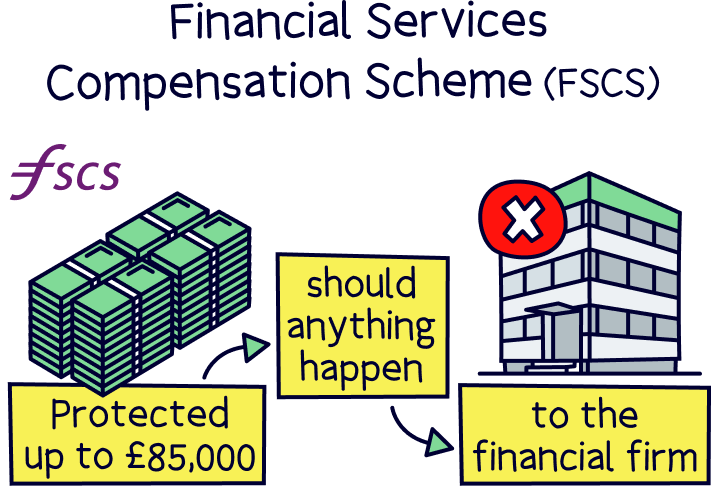
However, your investments within a personal pension are typically held with large investment companies or banks, so you’ve got even more protection. And these are all in your name, and can only be returned to you.
However, that doesn’t mean your money can’t go down in value – which can typically happen with pensions and investing. Your money typically grows considerably over time, but along the way there can be ups and downs – although don’t let you put this off, they’ll smooth out over time to typically build a large pension pot.
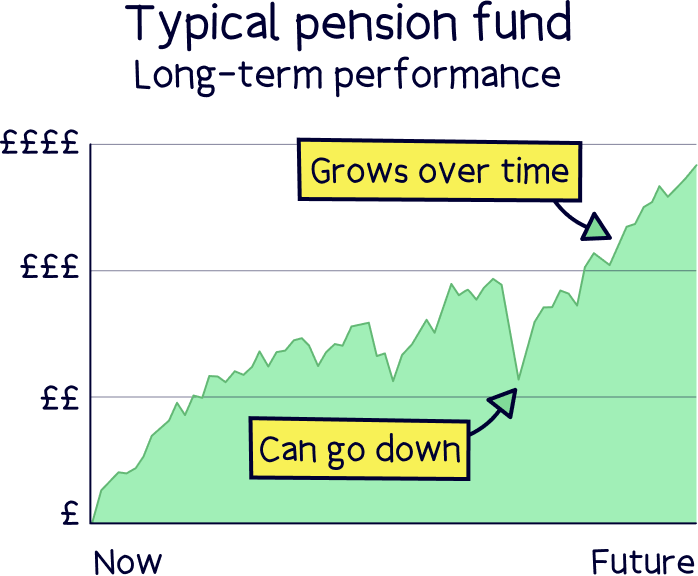
There we have it, how much you should have in your pension at 30. Well, not really how much you should have – it doesn’t really matter much at 30, it’s all about how much you can keep saving monthly from now on!
And how much you should be saving is all down to the retirement income you think you’d like when you retire. (All of the following figures include also receiving the State Pension).
For the recommended minimum retirement income of £14,400 per year, you’ll need a pension pot of £130,399. That’s a total monthly contribution of £220 per month.
For a moderate retirement income of £31,300, you’ll need a pension pot of £557,413, that’s a total monthly contribution of £940 per month.
And for a comfortable retirement income, you’ll need a pension pot of £853,039, that’s a total monthly contribution of £1,450 per month.
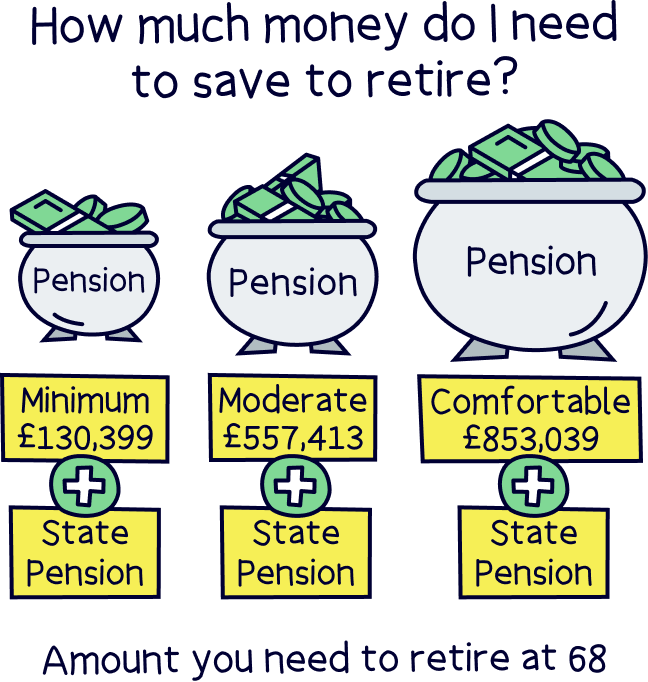
If you have got a pension pot already, you can reduce your monthly pension contributions slightly, but unless it’s pretty hefty, you’re still young enough that it won’t have a huge impact on your monthly contributions (just a little impact). As a recap, the current average pension pot at 30 in the UK is £9,300.
Saving for retirement doesn’t have to be hard or complicated. If you’re keen to save a bit more, and are already saving into a workplace pension, we recommend opening and saving regularly into a personal pension…
You’ll get a massive 25% bonus on your pension contributions, all added automatically, and your money can grow tax-free, all managed by experts.
Remember to pick a great pension provider that’s easy to use, has low fees and a great record of growing pensions over time.
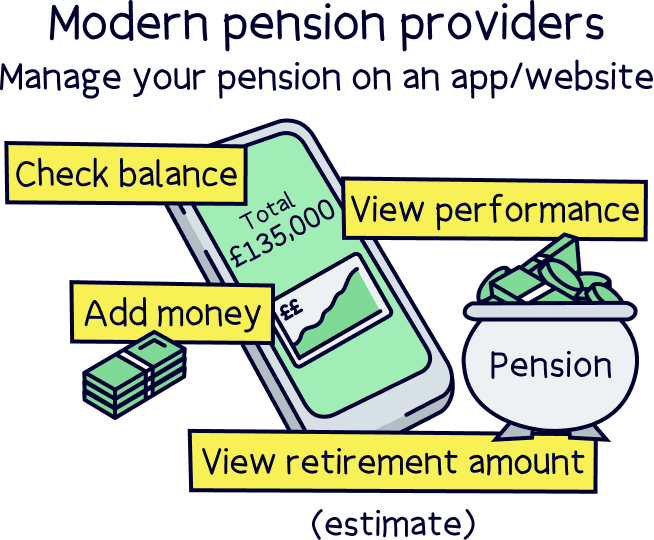
You can also move over any old pensions you have too! So everything is in one easy to manage place, and there’s no chance it’s getting lost.
Our top recommendation is PensionBee¹ – it’s easy to use and low cost, and you’ll even get £50 added to your pension for free when you sign up. You can compare all your options with our best personal pensions.
And that’s it. All that’s left to say to get saving! Your future self will really thank you.
PensionBee is our top rated provider, it’s easy to use and low cost – plus you’ll get £50 added to your pension when you open an account.
PensionBee is our top rated provider, it’s easy to use and low cost – plus you’ll get £50 added to your pension when you open an account.
We’d love to hear from you, and it will help others too.
PensionBee is our top rated provider, it’s easy to use and low cost – plus you’ll get £50 added to your pension when you open an account.